Morris Island Lighthouse Eco-Tour
Click on the first photo in each group and scroll to see the square photos at full size.
To start at the beginning of this series, visit Road Trip!
November was rearing its ugly head this morning as we took off for our Morris Island Lighthouse Eco-Tour, given by Charleston Outdoor Adventures (COA). The wind was brisk and the sun was nowhere to be found. We kept telling ourselves it had to be better than home, so just go with it. I suppose things could be worse – it could be raining. Conditions improved slightly as the day progressed – especially as we began our return from the island.
If you’re wondering “Just what is an Eco-tour?” – here is one answer: “With an emphasis on enriching personal experiences and environmental awareness through interpretation, ecotourism promotes greater understanding and appreciation for nature, local society, and culture.”
Here is another: “Ecotourism is about uniting conservation, communities and sustainable travel. This means that ecotourism activities should: A) Minimize physical, social, behavioral and psychological impacts and B) Build environmental and cultural awareness and respect.” – There are more, so click on the link to READ MORE about Ecotourism
As we pulled away from the dock, I’d like to think this plethora of pelicans (and other birds) were bidding us farewell, but since we weren’t in the kind of boat that returns with snacks for any of them, they couldn’t have cared less about us. And, I suppose that’s a good thing, since one of the goals of our eco-tour is to avoid disturbing the wildlife while we are checking out their habitat.
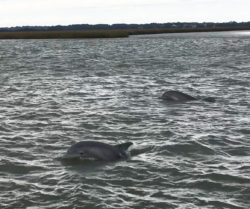 Today was the only day that this tour was offered during our early November visit. There were many other tours, as well as a Dolphin Tour offered the other days – which sounded tempting – but we love lighthouses. As it turned out, we saw plenty of dolphins anyway!
Today was the only day that this tour was offered during our early November visit. There were many other tours, as well as a Dolphin Tour offered the other days – which sounded tempting – but we love lighthouses. As it turned out, we saw plenty of dolphins anyway!
As you may have already discovered, dolphins are very hard to photograph. It’s not like they jump out of the water like whales. This gray day didn’t help matters, since there wasn’t much contrast between the water and the dolphins. I cut this photo from a video, which seemed to be the only way to catch them at all. We hung around this spot, with our boat bobbing in the water for probably 15-20 minutes while dolphins swam all around us. It was the highlight of my day!
If you take a look at the top photo again, you may assume that the lighthouse is ON the island and that you can get a closer look or maybe even go inside. As you get closer, it’s obvious that the waters of Charleston Harbor have washed away the land around the lighthouse, leaving it unaccessible – unless you want to go for a swim.
“The lighthouse is unusual in that it now stands several hundred feet offshore. When constructed in 1876 the light was approximately 1,200 feet (370 m) from the water’s edge. However, the construction in 1889 of the jetties which protect the shipping lanes leading to Charleston Harbor altered ocean currents, resulting in the rapid erosion of Morris Island and the destruction of many structures and historical sites (such as Fort Wagner). By 1938 the shoreline had reached the lighthouse, forcing its automation as it was no longer safe or practical to keep it manned. In 1962 the Morris Island Light was decommissioned and replaced by the new Charleston Light, located on Sullivan’s Island at the north end of the harbor.” – READ MORE about Morris Island Light
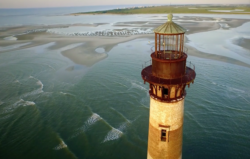
“The Time is Now – Save the Light”
There is a great website about a group called Save the Light.org that is trying to save the Morris Island Light from being lost at sea. For an amazing video showing arial views of the lighthouse up close from all angles, along with a plea for help, watch The Time is Now – Save the Light. This video by Daniel Crawford is narrated by Richard Beck and expresses the urgency of your donation, as this historic beacon may be on the verge of crumbling.
It was a rather chilly day and that swim wasn’t in the cards, so we wandered the beach and enjoyed the shells, kite surfers and sand. The wind was blowing the minimal vegetation almost horizontal at times, but on the up side – we were the only people on the island – and fewer visitors means more undisturbed shells. Jim found some great ones, as well as three sand dollars. Note to self: sand dollars do not travel well.
With only one other man on our tour, our guide was pretty laid back. He was very knowledgeable about the ecosystem of the area (which is actually an estuary) and was pleased to tell us all about it. This is why we love to take tours. You wouldn’t get this information if you rented a boat and ventured out on your own. Pretty much the rest of this post is only a portion of what he talked about and it was so interesting and exciting to hear about nature’s cleansing process, as well as the other tidbits he shared about the place he calls home.
“An estuary is a partially enclosed coastal body of brackish water with one or more rivers or streams flowing into it, and with a free connection to the open sea.
Estuaries form a transition zone between river environments and maritime environments. They are subject both to marine influences — such as tides, waves, and the influx of saline water — and to riverine influences — such as flows of fresh water and sediment. The inflows of both sea water and fresh water provide high levels of nutrients both in the water column and in sediment, making estuaries among the most productive natural habitats in the world.” – READ MORE about estuaries here
If you do plan to venture out on your own, be sure to take note of when low tide will be. Our tour was perfectly timed, as to not even think about the tide on our way out to the island. On the way back, our guide told several stories of folks who “didn’t even think about” low tide either, and ended up stuck in shallow waters. The seagulls are walking in the photo below showing just how shallow it gets. The good news is – when the water recedes, the oyster beds in massive oyster reefs filter the water – and I’m sure those seagulls have a few snacks as well. Just a few of the exposed oyster beds are pictured below. While submerged, those same oysters provide food and shelter for many organisms. READ MORE about South Carolina estuaries here.
Our guide also told us about the brown pelicans of the area (there’s one in the photo above). After spotting fish using their exceptional eyesight from way up high, they dive in to catch their dinner – with their eyes open to watch for any last-minute adjustments that may be needed. Over time, the repeated impact of diving into the water may give the pelicans cataracts and eventually may affect their ability to fish. Poor babies. I guess the more accurate they are, the less they have to dive and the better their chances for a long and happy life. Sounds like a great lesson for the kiddos.
The top photo just above is just one of the commercial shrimping companies in the Charleston area that has been helped by an idea that sounded pretty wild and crazy at the time. When most shrimpers were struggling with high fuel costs and low returns, Jimmy Buffett came to the rescue with an idea to revolutionize the shrimping industry. It probably helps with the cost of shrimp for his restaurants too, but that seems like a fair trade.
“Buffett’s food-centric epiphany came from a green tomato. Actually, the Green Tomato, his giant green surf van converted to run on used cooking oil, a process that is actually relatively simple compared with using biodiesel. The van is hard to miss, and driving around the United States in search of swells, Buffett found himself acting like an ambassador for the grease engine movement. “I felt like a teacher because I was giving lectures everywhere I went about the benefits of burning grease,” he says.
“My dream,” explains the musician, “is to get a big ole tanker truck, with huge holding capacity, and drive it up and down the Eastern seaboard collecting used cooking oil.” This from a man who’s built a mini-empire of concert tours, best sellers, and restaurants, and who could probably rest on his laurels somewhere besides the cab of a semi. “I want to collect all that used grease and distribute it to commercial fishermen along the coast to use as fuel for their boats.”
“These guys are always being screwed by the high cost of diesel,” Buffett says. And among fishermen, no one is more familiar with being screwed by high fuel costs and measly returns than the American shrimper. While shrimp prices have declined due to the flood of farmed shrimp onto the market, most of it imported from Asia, the same cannot be said for fuel.” – READ MORE about the “Grease Experiment” here
The wrecked boat pictured above was a casualty of Hurricane Hugo that struck this area head-on in 1989. The boat with the red mast in the next photo ran aground some time later. Those two boats had one thing in common. Due to the low shrimp prices the companies were getting around the time of their boats’ demise, it would have cost more to retrieve the boats and make repairs than they were worth, so there they sit – for years.
The skies were looking better and better as we returned to shore. I would take either one of the houses above!
If you find yourselves in Charleston and would like to learn more about the great outdoors of the area, check out Charleston Outdoor Adventures (COA). There are a number of different tours you can take – some are more adventurous than others.
On our last trip to Charleston we:
• Took a Public Tour on a Carriage (Private Tours are quite expensive)
• Shopped extensively at the Charleston City Market (mostly outdoors and just steps from Lodge Alley)
• Visited Fort Sumter National Monument
• Visited the Nathaniel Russell House
• Visited the Aiken-Rhett House (preserved, not restored)
• Took the DASH Trolley (free) to explore a little more of the city
Although we hate to leave, tomorrow we head to Savannah, GA – another place we can cross off our bucket list! We thoroughly enjoyed our time in Charleston (again). There is much more history to experience, shrimp to eat, martinis to sip and sunshine to soak up, so I know we’ll be back again soon.
Next up: Savannah, GA: Part One
Happy trails,
Barb


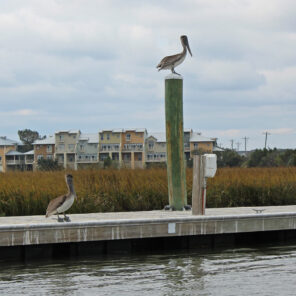
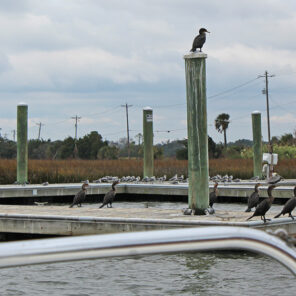

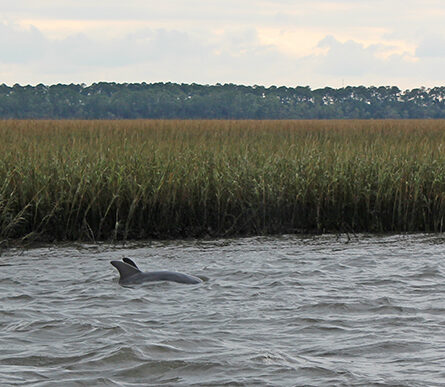
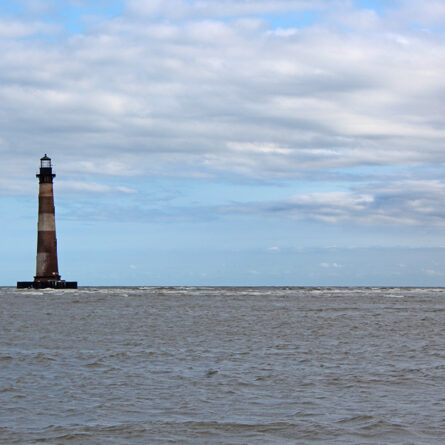
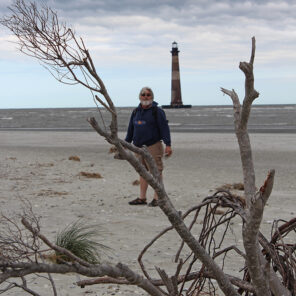
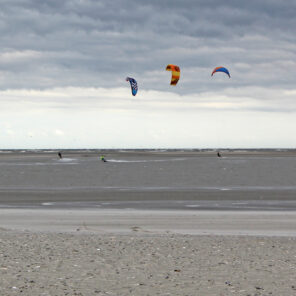
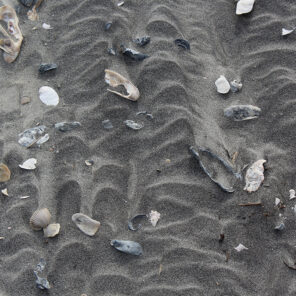
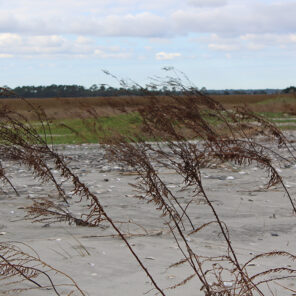
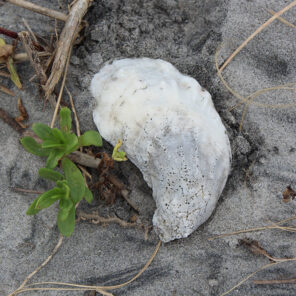



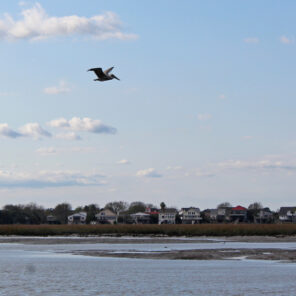
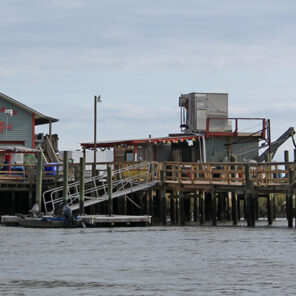

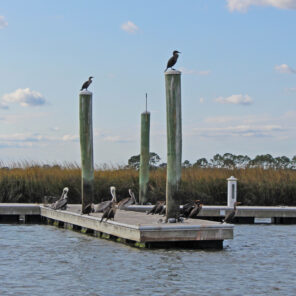
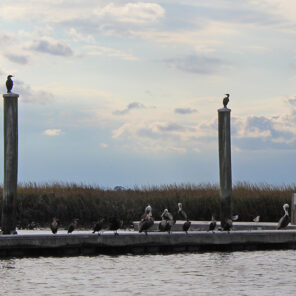
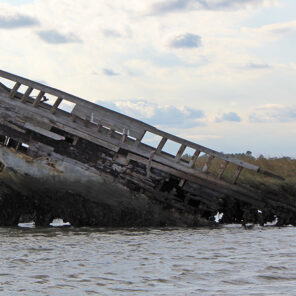


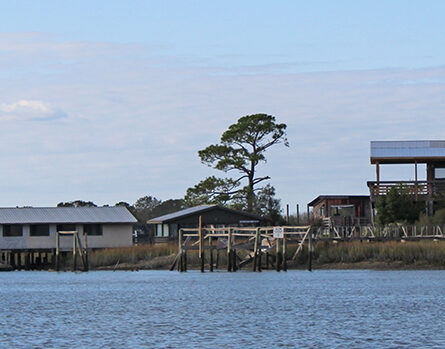
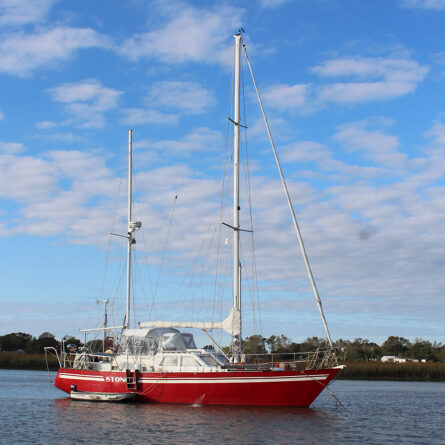
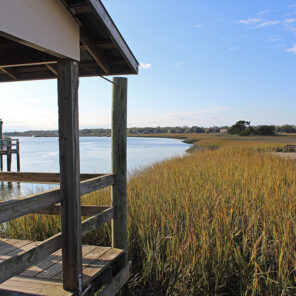

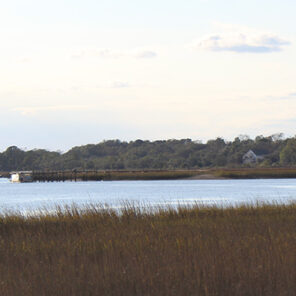




Thanks so much for your kind words. Stop back often, because as long as I can travel, I’ll be writing about it!
I just want to mention I’m very new to blogs and seriously loved your website. Very likely I’m want to bookmark your site . You certainly have remarkable well written articles. With thanks for revealing your web page.
Thanks very much! Keep coming back, because as long as I can travel, I’ll be talking about it!
Hello, I log on to your blogs like every week. Your humoristic style is witty, keep up the good work!
Thanks so much. I appreciate your kind words and hope you come back soon!
This is really interesting, You are a very skilled blogger. I’ve joined your feed and look forward to seeking more of your excellent post. Also, I’ve shared your site in my social networks!
Thanks so much Daniel! Have you been there?
Awesome Blogpost thank you for sharing.
Thank you very much! We had a lot of fun that day. I’d highly recommend!
Thanks Laurie!
Thanks, great article.
Love it!